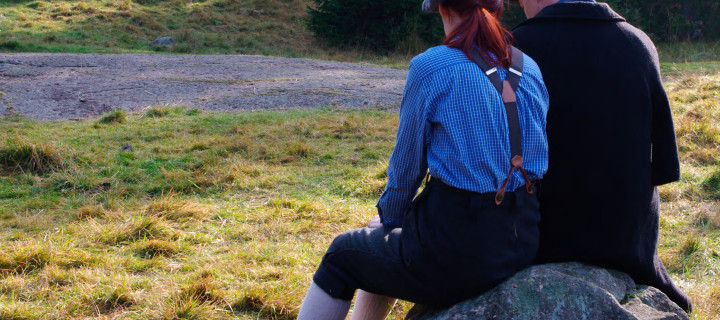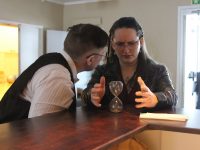Honor. Love. Patriarchy
The Game
 Brudpris (Bridal Price) is set in Berge, a rural village in the fictional Mo culture. The culture of Mo is inspired by Nordic rural 19th century aesthetics. They live isolated from the outside world according to their strict patriarchal honor culture.
Brudpris (Bridal Price) is set in Berge, a rural village in the fictional Mo culture. The culture of Mo is inspired by Nordic rural 19th century aesthetics. They live isolated from the outside world according to their strict patriarchal honor culture.
The culture of Mo requires every adult person to show control and restriction. Mo believe women carry a potentially dangerous force inside them – the Force of Life. If harnessed, this power will grant them children and allow the Mo people to live on. However, if women are not controlled by the men of Mo, the Mo people believe this power will destroy their land in a blaze of fire and chaos. The chaos within every woman can be stronger or weaker, but it is always there. Therefore, every woman must be the responsibility of an adult man, who will make sure her behaviour doesn’t endanger Mo.
The story in Brudpris revolves around the young boys and girls who are ready to leave the relative freedom of childhood behind and step into their respective roles as adults. Their fathers will find suitable partners for them, and every young woman will be married to a man who, from then onwards will be responsible for her. For the girls, this means an end to freedom; for the boys, the beginning of a crushing responsibility.
Design Note
 The original idea for Brudpris was to ‘turn up the volume’ on real world gender roles to make visible social norms and cultural practices we rarely notice in our real lives or would attribute to our own culture.
The original idea for Brudpris was to ‘turn up the volume’ on real world gender roles to make visible social norms and cultural practices we rarely notice in our real lives or would attribute to our own culture.
We chose the Nordic historical inspired setting to avoid creating an ‘otherfication’ effect. Had we, for example, chosen to set the larp in a setting close to what we as westerners consider to be ‘typical honor culture’ countries, we would not only have had severe problems navigating some cultural appropriation dilemmas, but also risked making it look like “these people are not like us” – which was the opposite of what we wanted.
Katrin is shaking after the forgiving-ritual. Hilda leads her beloved little sister into their tent where Katrin breaks down and starts crying. Hilda holds her and feels her own tears burning behind her eyelids, but she does not cry, just comforts her sister and dries her tears.
You did so wellsays Hilda,You did not cry out there where others could have seen!She corrects her sister’s head scarf and gives her a smile before they exit the tent again. Hilda walks with a straight back. She is a woman of Mo.
The meal is finished. The wife, Runa, says:
Tonight is the last night we dine together as a family.The sky, the moon and the heavens fall on Lars. But instead of showing this, he asks:Does anybody want some more water?Each member of his family replies with a nod. No words. No tears. It simply isn’t done in public in this family. They seek each other’s eyes, giving hints of their true feelings behind the facade. Still, the time they have left together isn’t enough. Not even close. Lars remembers he must get more water: Empty glasses look bad. He rises and imagines how his heart is left on the floor when he walks away. To feel and not allow yourself to show it. To love and not be allowed to say it.
For the people of Mo, living a respectable and good life is about control and order. The patriarchs of the families are the carriers of both their own and their family’s honor. Everything their family members do will reflect on them. Most families have a little more leeway in private, away from the eyes of others. Internal struggles are common, but no family would willingly expose these problems to others.
Design Note
Another design challenge was explaining and using honor as a design feature. Although most are familiar with the term honor culture, we knew that the full meaning of honor, and the impact it has, would be hard to communicate to the players. For this reason we chose to create a religious explanation as to why women had to be controlled and why men had to take responsibility for them. This was the Force of Life. It gave a reason why it was important to control women’s behaviour. As a natural consequence, women in this culture had the sexual initiative, since men were expected to control both their own and their wife’s sexual drive.
We also wanted to make clear that the honor culture of Mo was not a matter of personal choice or preference for the characters. It was integrated in every aspect of life, and going against the cultural norm would ha ve severe social consequences. Brudpris is chamber drama where the family unit is the focus of everyone’s play. Every family has secrets that can cause a public scandal if they are revealed. The feeling of constant pressure is kept by making public outbursts costly for everyone involved. Public scandals always have severe consequences. And if it is a woman who shames her husband, father or brother, she might be beaten publicly. Or in the worst case even killed.
The men watched each other, or they believed the other men watched them. At no point could a man show his true feelings or show any sign of weakness without losing face in front of his peers. For me, this was one of the hardest parts: To be forced to do terrible things, while not being allowed to share it with anyone in Mo. In the game setting, this was normal and part of the responsibility of being a man.
The Keips are the third gender of the Mo culture, recruited from boys who either fails the manhood test, or who don’t want to become men. The Keips are the only ones who can talk freely to anyone they wish; they play a key part in making the Mo culture function as a whole, crossing the social and cultural firewalls between men and women.
This culture makes for a slow and quiet gameplay. Players rarely show ‘big’ emotions; the drama is played out with discreet gestures instead of obvious ones. Things are said with gazes, a discreet touch, a mumbled word of comfort, a quiet tear that is quickly wiped away.
It was a terrible experience on many levels, this was really the quintessential nordic larp self-traumatizing emotional masochism that we all love and celebrate. But not a gratuitous one, like many strong games it had a basis in reality, that crept up on you afterwards and made you realize new things about people in the world.
Forgive us. You had no way of changing your life. For your sake – and mine – I will make my own life different.
You are just 34 years old and have many more years to live. I’m also 34, but my life is vastly different from yours and I will not let it go to waste.The only thing I want to keep with me from your life, is how your lust was so simple and powerful. It was probably the only positive thing about Mo. I will not be ashamed or let the culture – my culture, in the real world – turn me into a sexual object.
Some larp experiences you carry with you as not just a memory, but physically in your body. For me that is what happened after Brudpris. My character Hilda was a young woman. She was mature for her age and perfectly adapted to the violent honor culture she had grown up in.
It was easy, comfortable even, to slip into her subdued body language and thought patterns. It was like an amplified version of my own teenage insecurities. And after the larp I felt that it was hard to move quickly and act out; my mind had also been partly absorbed by her. I still can’t feel hatred towards the men who mistreated her, I just feel love.
Love because the violence was proof that she was loved and cared for. A Stockholm Syndrome so strong, it still lingers long after the larp is over.
And yet, that alluring lack of responsibility for my choices, that wish to be carried, that fear of talking and laughing too much, all resurfaced in you and moved you to give up everything.
I wish it all had come from you (Beatrice) – because I certainly didn’t want to find that in me. I’m sorry.
Design Note
 We can’t be sure if this is the first game designed with honor as its main design feature, but we can tell that we sure didn’t have many examples to look at. We wondered at several instances if this larp was playable at all, or if the extreme imbalance in player agency would make it entirely dysfunctional. Regardless, we knew the game would put pressure on both the male and female cast.
We can’t be sure if this is the first game designed with honor as its main design feature, but we can tell that we sure didn’t have many examples to look at. We wondered at several instances if this larp was playable at all, or if the extreme imbalance in player agency would make it entirely dysfunctional. Regardless, we knew the game would put pressure on both the male and female cast.
We wanted the (players who played) men to be powerful, and the (players who played) women to be close to powerless. Still, one must not believe we designed this game only for misery. We wanted to balance the horror and injustice by adding love, desire, affection, music and dancing. We wanted characters and families to feel relatable, like real people.
Brudpris is a game that will stay with us a long time. Seen from our eyes as organizers, it was both gut-wrenchingly sorrowful and soberly beautiful, horribly cruel and heartwarmingly human. And although we put as much dedication as we could into the game design and preparations, it is the players who made the vision come to life.Their dedication to this game, their characters and each other have been complete. It is by far the best reward a larp organizer can get.
Brudpris
Credits: Anna-Karin, Carolina Dahl- berg, Tor Kjetil Edland (producer) and Trine Lise Lindahl (producer)
Date: September 17 – 21, 2014
Location: Vestmarka, Norway
Length: 3 days
Players: 50
Budget: €6,000
Participation Fee: €110 (normal) €75 (youth)
Game Mechanics: Minimal. In-game cultural rules.
Website: http://brudpris.wordpress.com
This article was initially published in The Nordic Larp Yearbook 2014 which was edited by Charles Bo Nielsen & Claus Raasted, published by Rollespilsakademiet and released as part of documentation for the Knudepunkt 2015 conference.
Cover photo: Jan and Eskil in a conversation (Play, Simon Svensson). Other photos by Simon Svensson and Anna-Karin Linder Krauklis.







